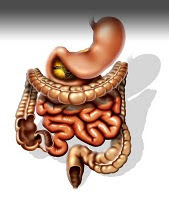 Intestinal Obstruction is complete or partial blockage in the intestines. This blockage prevents the solids, fluids and the gases from moving from the intestines normally. The obstruction may occur either in the small intestine or large intestine. Blockage of bowel may trouble you a lot if not taken care properly. A complete intestinal obstruction may cause complete absence of gas or stool. Partial blockage may cause diarrhea.
Intestinal Obstruction is complete or partial blockage in the intestines. This blockage prevents the solids, fluids and the gases from moving from the intestines normally. The obstruction may occur either in the small intestine or large intestine. Blockage of bowel may trouble you a lot if not taken care properly. A complete intestinal obstruction may cause complete absence of gas or stool. Partial blockage may cause diarrhea.Symptoms of Intestinal Obstruction :
- Cramping and pain
- Abdominal fullness
- Bad breath
- Abdominal bloating
- Constipation
- Diarrhea
- Vomiting
- Fetal and neonatal blockages are caused by the intestinal atresia where there is an absence of a part of intestine or a narrowing.
- Non mechanical obstructions are caused due to inflammation or due to the side effects or infections of certain medicines.
- Other causes are hernias, cancer and Crohn's disease.
- Sometimes a change in the food habits and life styles also causes such issues. It may make the waste material get harder and it becomes difficult to be eliminated.
- It may be due to tumors.
- Narrowing or twisting of intestines or scar tissues may be one of the reasons. Such blockages are mechanical blockage.
- In addition to changed food habits, changes in the water intake as well as exercise changes may also lead to bowel obstruction sometimes.
- Bowel obstruction may sometimes be due to the changes within the walls of abdomen area, bowel lumen or external to the belly area.
Nursing Diagnosis for Intestinal Obstruction
1. Deficient Fluid Volume related to nausea, vomiting, fever or diaphoresis.
Goal:
- Fluid requirements are met
- Normal vital signs
- Balanced input and output
Goal:
- The pain is resolved or controlled
- Patients revealed a decrease discomfort
- States pain level can be tolerated,
- Indicate relaxed.
Goal:
- The pattern of breathing becomes effective.
- Patients showed the ability to do breathing exercises
- Breathing deeply and slowly.
Goal:
- Anxiety is resolved
- Patients expressed an understanding of current disease
- Demonstrating positive kooping skills in dealing with anxiety.
No comments:
Post a Comment